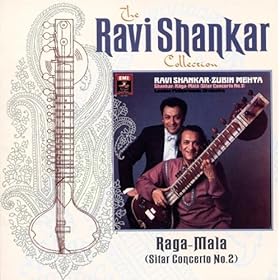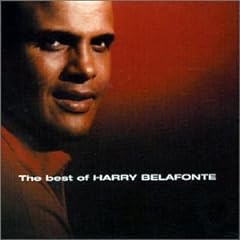This article is over over due, and my apologies to Viren and Kamal. What pushed me out of my laziness was a PM from SRRamanujam asking for my opinion on the Lyrita amps and speakers.
I visited Delhi on 25th of May to spend two days with Sound Of Music reviewing their Meridian, Avant Garde, Vienna Acoustics and other systems. I spent two days literally being overwhelmed with systems that are out of this world in price, technology, and delivery.
I had sent a PM to Kamal and was hoping to meet with him and just exchange some notes about music, systems and so on. Kamal, decided that we will meet at Viren's place and listen to his amp and speakers. Kamal was kind enough to pick me up from GK2, take me to Viren's place and drop me back after the demo.
First I would like to talk a bit about perceptions of people that we carry in our minds. My perception of Kamal and Viren were completely wrong when I met them in flesh and blood. I have a college colleague called Kamal Kumar Jain who also lives in Delhi and is a tailor by profession in Kamla Nagar. KK, as we call him, is a tall thin man who cannot put on too much weight as he stands for 8 hours a day cutting clothes that you give him. KK is a fastidious dresser, always wearing new and fresh clothes. My vision of our Kamal was always linked my own impressions of KK, and I was completely wrong. Our Kamal turned out to be very casually dressed, with a bit of a paunch, and a perpetually lost look on his face. Only when he opened his mouth could I match him with our HiFiVision Kamal.
I was even more wrong about Viren Bakshi. Based upon the threads I read about him and his replies, I always visualised Viren to be around 30 of age, short, wearing glasses, moody, US accented, and having his nose up in the air. In reality Viren turned out to be a very pleasant person, quite handsome, tall, and a little older than 30. And as others have vouched, he is a fantastic host.
Viren demonstrated the following equipment to me:
(1) Lyrita 2A3 SET integrated amplifier rated at 3 watts per channel. Single-ended output stage using Shuguang 2A3C valves, input and driver stage using 5687 valves. The rectified power supply is through 5V4G valve. All the transformers have been designed by Viren and manufactured from Delta Transformers, Delhi. The amplifier has just a single knob for volume control and nothing else.
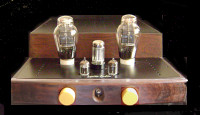
(2) Harmony One single driver, full range speaker system, using 6" Fostex FE167E drivers. Cabinet design is a TWQT - Tapered Quarter Wave Tube - which helps reinforce the low frequencies. These designs are based on work done by Martin King. The cabinets are made from solid Sheesham, similar to Rosewood. To test the cabinets, I knocked on them and nearly broke my knuckles. This was a good sign.

The speakers cabinet are quite tall - nearly 5 feet in height. They are tapered slightly backwards. In essence, since the driver is parallel to the tapered front side of the cabinet, they will be facing a bit upwards and will not be perpendicular to the ground. This design is supposed to balance sharp peaks and dips in frequency as well as remove hearing fatigue completely. I have seen a similar design in a few other speakers and have personal experience with only Rajiv's Lithos speakers. But those are in a completely different league.
The Fostex drivers have cones made from banana pulp. They are completely white in colour. The drivers have been treated with the EnABL pattern invented and patented by Bud Purvine. The technology is a bit complicated to understand, but let me try to explain in layman terms as well as I can. It is believed that two distinct standing waves are present within all drivers. One of these standing waves is inherent to the driver's construction itself, and the other is a transient phenomenon at the outer boundary of the cone. Bud invented a effective solution to eliminate the standing waves by creating small energy gradients along the outer boundaries of the cone. These gradients are small rectangles that are created by using a glossy paint. The thin coating applied at the edges increases the energy density, enables a smoother flow of sound, and thus eliminates both standing waves.
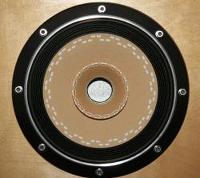

For a full note on the Bud Purvine technology, please visit
standingwaves
The source was a Marantz 5001 CD Player. All interconnects and speaker cables were made by Viren himself with spades and connectors imported from Taiwan.
I had forgotten to take my camera, so I had to request Viren to send me some pictures which he did.
Viren had kept the amp on for about 30 minutes before we arrived. This was the time needed for the amp to warm up and deliver to it's full potential. This was the same I heard from Sharath about the Wavac tube based systems.
Let me explain the listening room to make you understand the listening environment. Viren lives in a DDA flat in Sarita Vihar [Corrected (from Saket) after prompting by Amitnoida below. Thanks Amit]. The room the amp and speakers were set up was about 12 odd feet wide and about 20 feet long. The door to the room was at one of the 20 feet wall. As soon as you enter, Viren had placed two chairs along the 12 feet wall. The Amp and speakers were placed diagonally opposite just before the second 12 feet wall. As you are sitting in the chair, the CD player and power conditioning equipment were placed on a rack to your right somewhere in the middle of the 20 feet wall. There were long interconnect cables (again corrected from Speaker cables, thanks to ANM) that ran on the ground from the CD player to the amp.
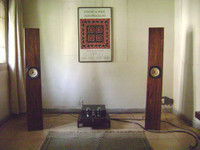
The amp is placed on a small stool and sits squarely between the two speakers. The speakers themselves were a couple of feet from the wall to their rear and had a distance of roughly 7 od feet from each other. The room was completely bare excepting for what I had explained above. There were two small windows to your left as you sat on the listening position. The windows, if I remember right, did not have any drapes. The room was bare of any acoustical treatment whatsoever including a carpet. An ideal environment I would say for someone who wants to buy the amp/speaker combination and just use them in an untreated room. But then, I personally felt the sound stage would have been much much better with minimal acoustical treatment on the room.
Viren played some of his favourite CDs which included some Jazz, some Wind Instruments, and some numbers by Patricia Barber, Unfortunately, I had not heard these before so I could not comment on the delivery. But one things I must say. I was sitting some 10 to 12 feet from the drivers, and with the volume knob at 11 'O' clock position, the drivers were throwing nearly 80dB of sound at me effortlessly. I was stunned by the amplitude that a 3 watt amplifier could generate. I must say this was the first time I had come across a system where the amplifier and speakers were perfectly matched.
Viren, during this demo, was saying that the only thing the system lacked in delivering well was very low frequencies. I found the drums to be good and adequate. After some discussion with Viren, I realised that the system may not be able to deliver the artificially low boomy sounds of electronic drums, but plays real drums quite well. The beat of drums were tight and extremely fast, a feature of amplifier and loudspeakers I simply love.
OK, now was the time to take out my own CDs out and listen to numbers I am familiar with.
We started with Harry Belafonte as somehow I felt the system would be happy with a deep baritone voice. I was right. The 2A3 SET was really happy with my choice. It picked up and Harry's voice, and placed it dead centre between the speakers and surrounded it with the simple instruments played at low volume. The separation of the voice and the instruments was decent, and I could clearly hear the soothing violins that were played. Playing Harry Belafonte got Viren, Kamal and I reminiscing about 'Forces Requests', a radio program that used to be played by Delhi B many years ago at 2100 hours every Monday. It was in Forces Requests that we Neanderthals got close to Harry Belafonte, Elvis Presley, Cliff Richard, Tom Jones, and singers like that.
Next we played a few numbers from Katie Melua's Piece By Piece. In Shy Boy and Nine Million Bicycles, Katie's voice was silky smooth and caressing your ears. The instrumentals again were very decently separated from the voice, and the same time, working with her to present a good sound stage.
To push the system a little, I decided to play Raga Symphony by Pandit Jasraj and Shaarangadev Pandit. For those of you who are not familiar with this album, let me give a little background. Hindustani and Carnatic numbers are usually a single individual affair. These are either human voices or some instruments such as Sitar, Violin, etc. These are supported by a percussion, and a tampura to set the rhythm. Singers are generally supported by a single violin player, more to give the singer some breathing time than anything else. Some 10-15 years ago, Ravi Shankar attempted to break this mold by using the Royal Philharmonic Orchestra to play some classical Indian ragas along with his Sitar. Conducted by Zubin Mehta, the Orchestra created a sound stage that is simply incredible. Called Raga Mala, this is one of the few albums I can listen to hundreds of times without tiring. Pandit Jasraj was the second artist to attempt this on a similar scale. With an ensemble of nearly 60 artists he plays the various ragas using keyboards, drums, chorus, Sitar, Chinese flute, Santoor, Veena, Sarangi, violins and violas. There are some 20 violins that are played together. Like the Raga Mala, the Raga Symphony is a mesmerising album that makes you sit up, listen, and dance to the tune.
When Viren played the Raga Symphony, I really sat up. It was as if the various groups of instruments and singers were lined one beside the other in front of me. The separation of some 15 odd groups of instruments were that clearly done. When a sitar would start, a Veena would step back, and take its place again when called to. When I closed my eyes, I felt I was sitting on the floor with the artists forming a semi circle in front of me. One thing missing was the throw of sound. But I felt this was because of my distance from the speakers. If I had sat some 10 odd feet from the speakers, I am sure I would have been completely enveloped by the sound. In Track 3 - A Faint Flutter - some halfway through the number, the violins start to crescendo the raga set by the Sitar. I was wondering if there was any space the violins could play in the sound stage and whether they would kind of get meshed with the other sounds. I need not have worried. The violins found a space between the amplifier and the left speaker and beautifully rendered themselves. Just imagine 20 violinists standing one behind the other in just two rows. The 2A3 SET was able to create that tight sound stage to give precision imaging of the artists and their instruments.
Viren opened the 2A3 SET and showed the internals to me. There was literally nothing inside excepting the power transformers and wiring that led to the tubes in the front. At the back were the good looking input connectors and binding posts. Very simplistic and very elegant. The 2A3 SET may not have the sophisticated finish of some imported tube amps, but they perform very well indeed.
The amp/speaker combination do have some short comings. If you are looking for earth shaking bass, you will be disappointed. As I said before, they cannot render electronic music, particularly drums, well, so hard rock lovers should look elsewhere. For all other kind of music, the combination is very good indeed. It will be particularly good for vocals and Western Classicals. Another area where the Lyritas
may struggle with is extremely high pitched voices. I would like to hear a few Lata and Asha numbers to see how the 2A3 SET handles them. I did discuss this with Viren who was quite confident he could tune the system to individual tastes, if required. That is a great advantage from mass market players.
A couple of impressions that I would like to add, and these are purely my personal opinions. For one, I think Viren must do up his demo room a little in terms of acoustics. It will vastly improve his demonstrations. In a properly treated room, the amp/speaker combination can be heard at low volumes with really good clarity. This combination must be heard at some 40/50dB to be really enjoyed. With collateral noise, you may be forced to increase the amplitude bringing the possibilities of distortion, particularly in complicated albums.
Second in HFV and elsewhere I have often read people say the sound of tubes is more analog'ic' and more lifelike. I expected the Lyritas to sound completely different from a vast number of SS amps I have heard. This did not happen. I could not differentiate the Lyritas sound from a number of good and expensive SS amps that I have heard. I personally felt that a well constructed tube amp, and a well constructed SS amp would sound quite similar, at least to my ears.
Well done Viren.
Cheers








